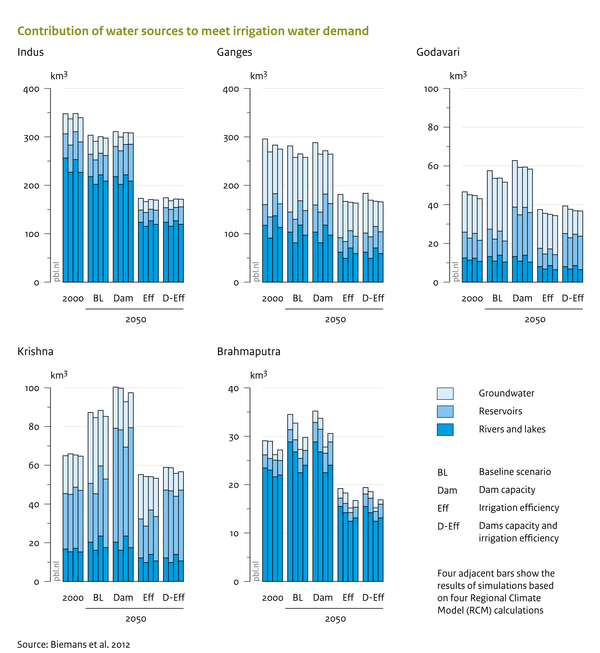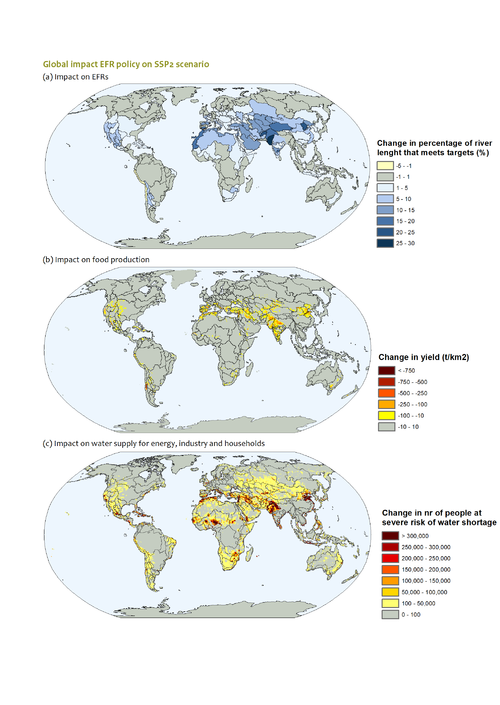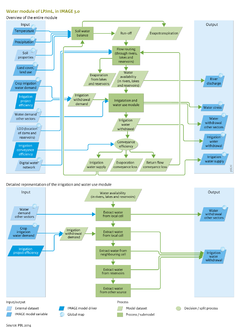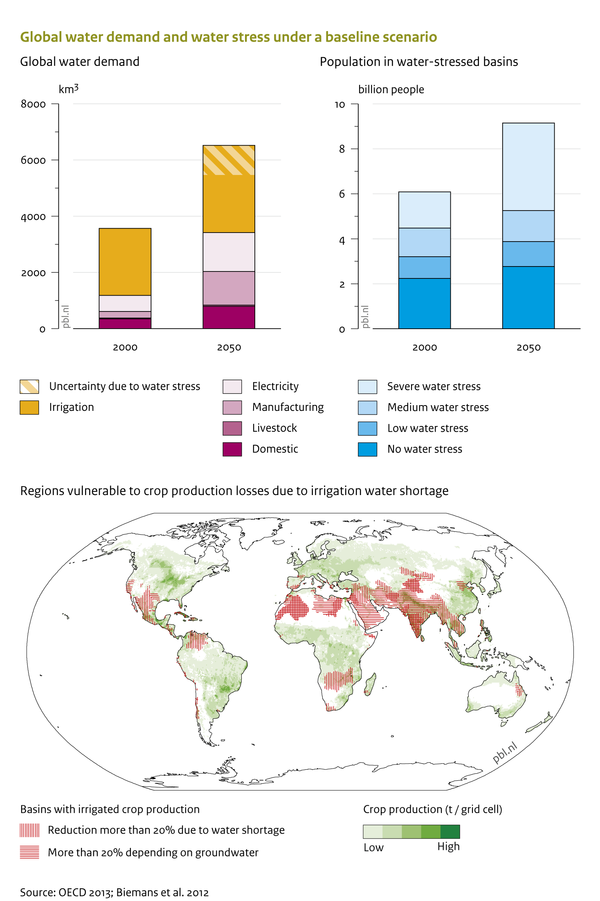Water/Policy issues
Parts of Water/Policy issues
| Component is implemented in: |
|
| Related IMAGE components |
| Projects/Applications |
| Key publications |
| References |
Baseline developments
In baseline scenarios, water use is typically projected to increase rapidly. This can be illustrated in the baseline scenario study for the OECD Environmental Outlook to 2050 (OECD, 2012), in which water demand is projected to increase by 53% globally, mostly due to a high increase in non-agricultural water use (the figure below). However, this baseline scenario did not consider irrigated area expansion, which is expected to further increase demand for irrigation water (the figure below top left). As a result of the increase in total water demand, and a change in water availability due to climate change, the number of people living in medium to severely water stressed basins will increase by 80%, according to this baseline (the figure below top right).
Expansion of rain-fed and irrigated croplands together with increased crop yields are projected in studies on the future of the global food system (Fischer et al., 2005; Molden, 2007; Alexandratos and Bruinsma, 2012; Gerten et al., 2013). However, irrigation expansion and related increases in crop yields may not be feasible because of water scarcity (the figure below bottom).
Policy interventions
Several water-related policy interventions can be assessed with IMAGE-LPJmL, including improved rainwater management, improved irrigation efficiency, increasing storage capacity and land-use related interventions. For example, Rost et al. (2009) evaluated the effect of improved rainwater management on crop production by decreasing soil evaporation and increasing rainwater harvesting. Biemans et al. (2012) tested the effect of improved irrigation efficiency and expansion of storage capacity on irrigation water demand and available sources of supply for five river basins on the Indian subcontinent (the figure below). Jägermeyr et al., 2017 concluded that 41% of current irrigation withdrawals depend on water at the expense of the environmental, but that improvements in irrigation efficiencies and water management can avoid these negative impacts.

In combination with the crop model, the effect of land-use related policy interventions could be addressed, such as changes in crop types or improved land and water allocation (e.g. Bijl et al., 2018a). With the module for Environmental Flow Requirements (EFRs), impacts of prioritizing EFRs on other water users can be analyzed, and vice versa (De Vos et al., 2021 and figure below).

Effects of policy interventions on this component
| Policy intervention | Description | Effect |
|---|---|---|
| Changes in crop and livestock production systems | General changes in crop and livestock production systems, e.g. more efficient production methods to create higher production per unit of input, or other systems like organic farming | Increasing the productivity of crops by converting rainfed to irrigated agriculture will have an effect on the irrigation water demand in the region. Extracting more water for irrigation will have an effect on downstream water availability and can increase water stress in the region. |
| Improved irrigation efficiency (*) | Improved irrigation efficiency assumes an increase in the irrigation project efficiency and irrigation conveyance efficiency. (Reference:: Biemans et al., 2013) | If irrigated area is not expanded, improving the irrigation efficiency on a large scale will decrease irrigation water withdrawals for irrigation. This means that water availability downstream will increase and water stress will get lower. |
| Improved rainwater management (*) | Improved rainwater management assumes a decrease in the evaporative losses from rainfed agriculture and the creation of small scale reservoirs to harvest rainwater during the wet period and use it during a dryer period. Both measures lead to more efficient use of water and increased yields on rainfed fields. (Reference:: Rost et al., 2009) | Improved rainwater management will lead to more efficient use of rainwater over the year and therefore a better fullfillment of crop water requirements. Further it will lead to more efficient use of the soil moisture because of a decrease in evaporative losses from bare soil. Both measures lead to increased yields of rainfed agriculture. |
| Increased storage capacity (*) | Increasing storage capacity assumes that the total water volume stored in large reservoirs will increase. This can either be established by an increase of the capacity of existing reservoirs, or by building new reservoirs. (Reference:: Biemans et al., 2013) | Increasing the storage capacity of reservoirs will lead to a reduction in streamflow variability and an increase in the amount of water stored in the river system. In basins that have a very variable flow regime, a storage reservoir can increase the water availability for irrigation during dry periods. |

